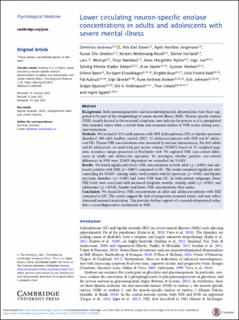Lower circulating neuron-specific enolase concentrations in adults and adolescents with severe mental illness
Andreou, Dimitrios; Steen, Nils Eiel; Jørgensen, Kjetil Nordbø; Smelror, Runar Elle; Wedervang-Resell, Kirsten; Nerland, Stener; Westlye, Lars Tjelta; Nærland, Terje; Myhre, Anne Margrethe; Joa, Inge; Reitan, Solveig Merete Klæbo; Vaaler, Arne; Morken, Gunnar; Bøen, Erlend; Elvsåshagen, Torbjørn; Boye, Birgitte; Malt, Ulrik Fredrik; Aukrust, Pål; Skrede, Silje; Kroken, Rune Andreas; Johnsen, Erik; Djurovic, Srdjan; Andreassen, Ole; Ueland, Thor; Agartz, Ingrid
Journal article, Peer reviewed
Published version

Åpne
Permanent lenke
https://hdl.handle.net/11250/2829728Utgivelsesdato
2021Metadata
Vis full innførselSamlinger
- Department of Clinical Science [2318]
- Registrations from Cristin [9791]
Sammendrag
Background: Both neurodegenerative and neurodevelopmental abnormalities have been suggested to be part of the etiopathology of severe mental illness (SMI). Neuron-specific enolase (NSE), mainly located in the neuronal cytoplasm, may indicate the process as it is upregulated after neuronal injury while a switch from non-neuronal enolase to NSE occurs during neuronal maturation.
Methods: We included 1132 adult patients with SMI [schizophrenia (SZ) or bipolar spectrum disorders], 903 adult healthy controls (HC), 32 adolescent patients with SMI and 67 adolescent HC. Plasma NSE concentrations were measured by enzyme immunoassay. For 842 adults and 85 adolescents, we used total grey matter volume (TGMV) based on T1-weighted magnetic resonance images processed in FreeSurfer v6.0. We explored NSE case-control differences in adults and adolescents separately. To investigate whether putative case-control differences in NSE were TGMV-dependent we controlled for TGMV.
Results: We found significantly lower NSE concentrations in both adult (p < 0.001) and adolescent patients with SMI (p = 0.007) compared to HC. The results remained significant after controlling for TGMV. Among adults, both patients with SZ spectrum (p < 0.001) and bipolar spectrum disorders (p = 0.005) had lower NSE than HC. In both patient subgroups, lower NSE levels were associated with increased symptom severity. Among adults (p < 0.001) and adolescents (p = 0.040), females had lower NSE concentrations than males.
Conclusion: We found lower NSE concentrations in adult and adolescent patients with SMI compared to HC. The results suggest the lack of progressive neuronal injury, and may reflect abnormal neuronal maturation. This provides further support of a neurodevelopmental rather than a neurodegenerative mechanism in SMI.
